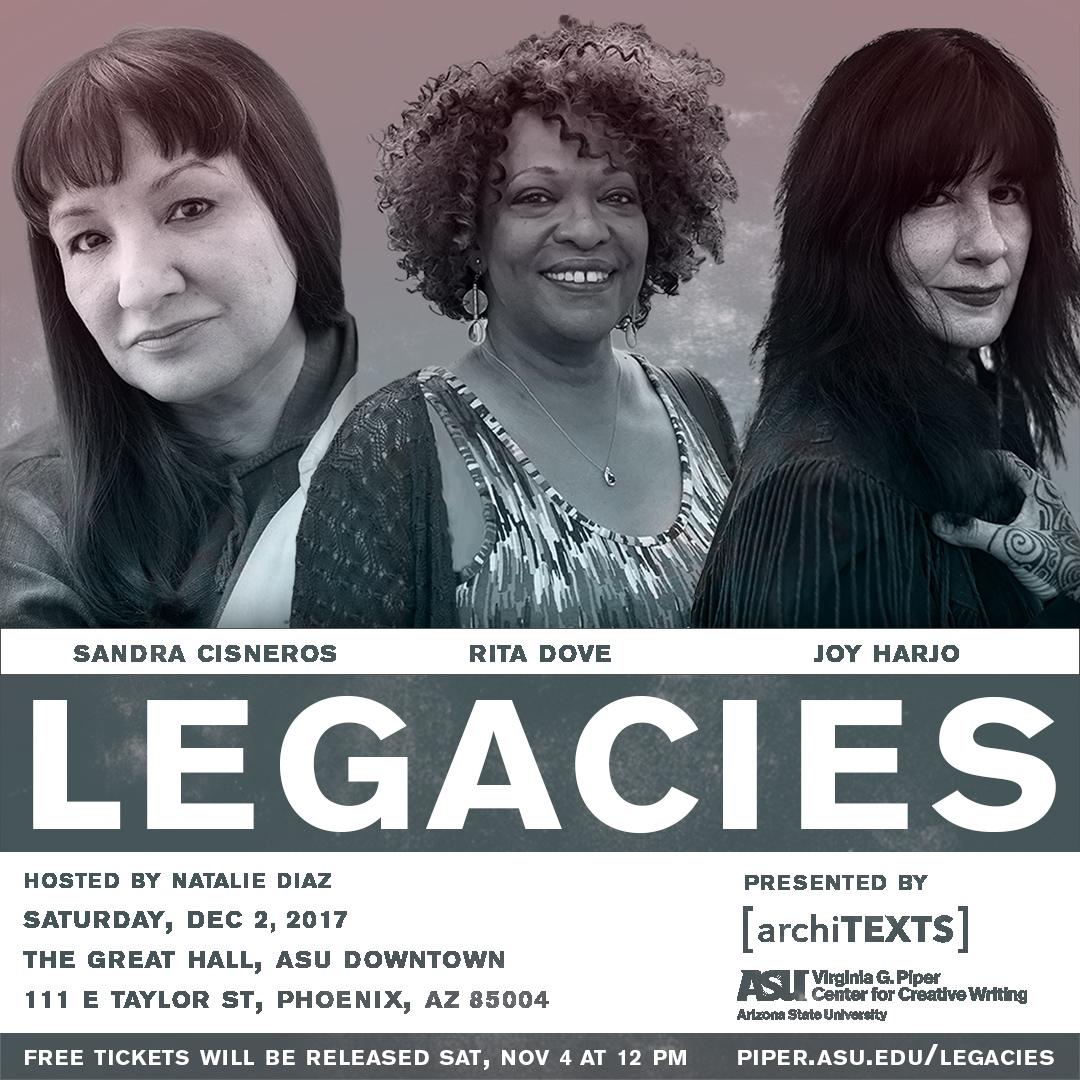In the 1970s at the famed Iowa Writers’ Workshop, Sandra Cisneros, Rita Dove and Joy Harjo were the only non-white students. Each went on to have a successful literary career, brazenly bucking traditional notions of who a writer ought to be and the kinds of stories they ought to tell.
Their influence was felt by many who followed in their footsteps, including ASU Assistant Professor of English Natalie Diaz, who teaches courses in the Creative Writing Master of Fine Arts program.
“Sandra, Rita and Joy were part of a group of writers who put pressure on the traditional MFA structure, and it is this pressure which is allowing marginalized stories to be returned to the center, rather than exist through a gaze of diversity,” Diaz said.
On Saturday, Diaz will host “Legacies: A Conversation with Sandra Cisneros, Rita Dove and Joy Harjo” from 1:30 to 3 p.m. at the Beus Center for Law and Society, room 140, on ASU’s Downtown Phoenix campus. There is an additional event featuring the three authors Friday at the Phoenix Art Museum. Both events are at capacity, but the Saturday event will be livestreamed; find details on the Facebook event page.

The event is presented by archiTEXTS, a program started by Diaz to help build conversations — on and off the page — and collaborations between people who value poetry, literature and story, as well as the Virginia G. Piper Center for Creative Writing, with support from the Labriola National American Indian Data Center and the University of Arizona Poetry Center.
The authors are expected to discuss their personal journeys through the American literary landscape.
“They have never been brought back together [since their time at University of Iowa],” Diaz said, “so it is a momentous event to have them here in one space.”
ASU Now spoke with Diaz ahead of the weekend events to gain some insight into the trio’s significance.
Natalie Diaz
Question: What contributions did these women make to the literary field?
Answer: Sandra, Rita and Joy were three game changers who forced the wheel of change to turn in MFA programs across the country. Their successes as writers, mentors and teachers defy the archaic structures of some MFA programs, including the structure in which the majority of faculty and students are white. Writers such as Junot Diaz and Viet Thanh Nguyen have written critically about what it is like to be a non-white student in an MFA program.
The student body of most MFA programs today mirrors the literary landscape, which is a mixture of races, languages, ethnicities, nationalities, genders and sexualities. And in time, in order to be in conversation with this rich American literary movement, the faculties of MFAs will have to change to reflect this. Sandra, Rita and Joy were part of a group of writers who put pressure on the traditional MFA structure, and it is this pressure which is allowing marginalized stories to be returned to the center, rather than exist through a gaze of diversity.
Q: How did they influence you as both a minority woman and a writer?
A: The voices of these three women have been extremely important to me. It is difficult to exist in a space where you feel invisible. Many MFA students don't see a reflection of their bodies, their lives, their experiences, their values and histories, or their futures in the spaces of their classrooms. There were times when I was the only student of color in my MFA program, and I was lucky to have faculty of color, who never made my workshops feel anthropological or in need of cultural explanations.
Cisneros, Dove and Harjo have made many writers possible because their existence is acknowledged as a center instead of gesture toward diversity. They have ensured that the stories of writers of color are part of American literature. When I first encountered their works, I felt my own life, my family, my beloveds, the America that I knew and experienced. In their work I was made visible. One of the reasons I asked them to come to ASU and to Phoenix is because I want to offer this to my students, this acknowledgement of personhood, and the power of story and poetry in our lives.
Q: Do you have a favorite work of theirs?
A: One of Sandra's most referenced works is “The House on Mango Street," which is beautiful and which continues to impact the writing and reading lives of many people. “Woman Hollering Creek” is my favorite book, and a book I return to often with my own students. Rita Dove’s “Collected Poems” is beautiful, and if you have never read her work before, it will give you a great introduction to her. Joy Harjo's recent book, “Conflict Resolution for Holy Beings,” is a book which changes the hours of my day when I read it, a book about the kind of heart and world I want to be possible.
More Arts, humanities and education

March Mammal Madness hypes science, storytelling in the classroom and beyond
In classrooms throughout the country, the buzz around March Mammal Madness starts long before the tournament begins. For middle school science teacher Jessica Harris, students wonder which…

Different ways of thinking, different ways of thriving: How ASU is supporting students with autism
According to the CDC, over 5.4 million adults in the U.S. are living with autism spectrum disorder, a condition that affects how individuals interact with others, learn and process information.…

Forever sewn in history
The historical significance of Black influence on fashion spans centuries. From the prints and styles of Africa to various American political climates, Black fashion has sealed its impact on the…

